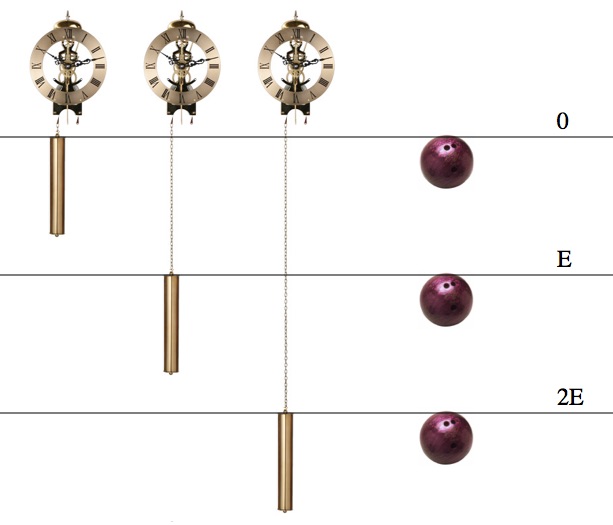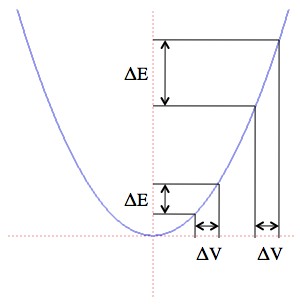The original question was: … the formula for kinetic energy is and the formula for momentum is
. I ran into these in physics class long ago and was really bothered by the first formula. How can energy go up as the square of the velocity? It’s certainly not intuitive (I know, science is often not intuitive, but still).
Worse, you would think that momentum would go up hand in hand with kinetic energy, when the formulas above instead show the latter going up much faster due to the exponent. This also doesn’t make sense.
I’m sure you can do some math to show why it has to be this way, but can you explain in non-math terms why kinetic energy and momentum behave this way?
Physicist: This is pretty unintuitive. In fact, historically this was a whole thing. Buckets of profoundly smart folk argued and debated about whether velocity (momentum) or velocity squared (energy) was the conserved quantity. Turns out it’s both. The difficulty is first that energy can change forms and second that up until the 20th century lab equipment was terrible (and often home-made).
Force is mass times acceleration: F=ma. If you apply a force over a time you get momentum and if you apply force over a distance you get energy. Acceleration times time is velocity, so it should more-or-less make sense that force times time is momentum: . What’s a lot less obvious is energy.

Whether it’s lowered slowly or falling freely, a weight gains the same amount of energy. If it falls twice as far it gains twice the energy.
A decent way to think about force and kinetic energy is to consider a falling weight. Gravity applies a constant force and thus a constant acceleration. If you tie a string to that weight you could power, say, a clock. Every meter it’s lowered it provides the same amount of energy, so lowering it 2 meters provides twice the energy as lowering it 1 meter.
Now imagine the weight free-falling that distance (instead of being slowly lowered). After the first meter it’ll already be moving, so it’ll fall through the second meter faster and in less time. The velocity gained is acceleration times time, so since it spends less time falling through that second meter, the falling weight spends less time accelerating and gains less speed.
But it still has to gain the same amount of energy every meter it falls. Otherwise weight-powered clocks would act really weird (a chain twice as long would yield only √2 as much energy). That means that at higher speeds you gain the same amount of energy from a smaller increase in speed. Or (equivalently) once you’re moving faster, the same increase in speed produces a greater increase in energy. This sometimes seems to produce paradoxes, but doesn’t.
With a little work and some calculus (see the answer gravy below) you can make this a lot more rigorous and you’ll find that the relationship between energy and velocity is exactly . In fact, figuring out this sort of thing is a big part of what calculus is for.
If it bothers you that energy doesn’t scale proportional to velocity, keep in mind that we’ve got that covered: momentum. Ultimately, both momentum and energy are just names for numbers that can be calculated and for which the total never changes. That which we call momentum by any other name would be as conserved.
Answer Gravy: Energy or work is force times distance: E=FD. When all the variables are constant finding the work done is just a multiplication away. However, when the variables aren’t constant finding the work done requires integration. The question of this post is one of the big reasons behind why calculus was originally invented. If you want to learn intro physics then please, for your own sake, learn intro calculus first. It is so much easier to talk about position, velocity, and acceleration (intro physics) when you can say “acceleration is the derivative of velocity and velocity is the derivative of position”. If you start physics with just a little calculus background, then you and your physics professor will high-five at least twice daily. Guaranteed.
Instead of a single distance with a constant force, we chop up the distance into lots of tiny pieces dx long and add them up. So a better, more universally applicable way of writing “E=FD” is , where the force is written “F(x)” to underscore that it may be different at different locations, x.
What we’ll calculate is the energy gained by an object that starts at rest, is pushed by a force F(x) over a distance D, and moves from position x=0 at time t=0 to position x=D at time t=T.
When we say the object started “at rest” we mean “v(0)=0”. Whatever v(T) is, it’s the velocity of the object when we’re done. So, the energy gained by an object that starts at rest and is pushed up to some speed v is .
Huzzah for calculus!








16 Responses to Q: Why does kinetic energy increase as velocity squared?